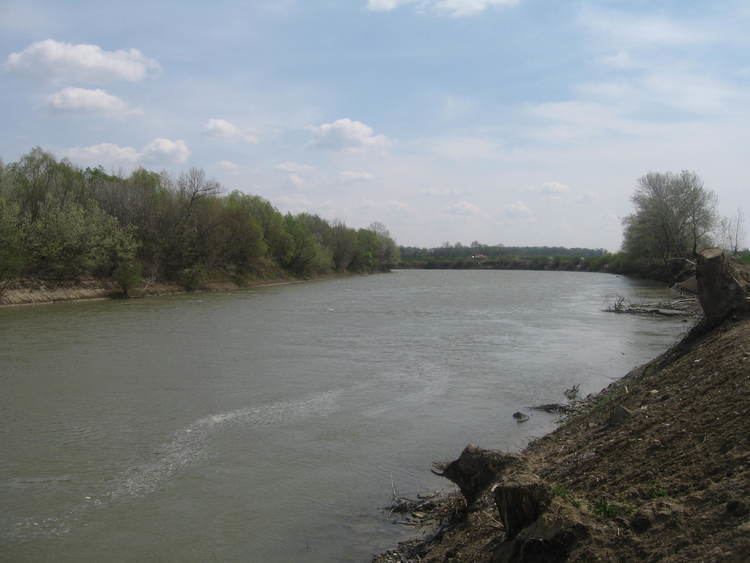- right Cheremosh, Jijia Basin area 27,500 km² Mouths Galați, Danube | Length 953 km Discharge 110 m³/s | |
 | ||
- location Mt. Hoverla, Ivano-Frankivsk O., Ukraine - location Giurgiulești, Romania/Moldova - average 405 m/s (14,302 cu ft/s) - max 6,030 m/s (212,947 cu ft/s) - min 110 m/s (3,885 cu ft/s) Sources Ukraine, Carpathian Mountains, Hoverla Bridges Eiffel Bridge, Ungheni, Lipcani-Rădăuți Bridge Cities Chernivtsi, Kolomyia, Ungheni, Cahul, Leova | ||
The Prut (also spelled in English Pruth or on maps as Prout; [prut], Ukrainian: Прут) is a 953 km (592 mi) long river in Eastern Europe. In part of its course it forms Romania's border with Moldova and Ukraine.
Contents
Map of Prut river
Overview
The Pruth was known in antiquity as the Pyretus (Ancient Greek Πυρετός), Porata (possibly), Hierasus (Ιερασός) or Gerasius. It originates on the eastern slope of Mount Hoverla, in the Carpathian Mountains in Ukraine. The Prut flows southeast, eventually joining the Danube river near Giurgiulești, east of Galați.
Between 1918 and 1939, the river was partly in Poland and partly in Greater Romania (Romanian: România Mare). After the German invasion of Poland in 1939, it became almost entirely Romanian. Prior to World War I, it served as a border between Romania and the Russian Empire. After World War II, the river once again demarcated a border, this time between Romania and the Soviet Union. Nowadays, for a length of 695 km, it forms the border between Romania and Moldova. It has a hydrographic basin of 27,500 km2, of which 10,990 km2 are in Romania and 7,790 km2 in Moldova. The largest city along its banks is Chernivtsi, Ukraine.
The Stânca-Costești Dam, operated jointly by Moldova and Romania, is built on the Pruth. There is also a Hydro-Electric Station in Snyatyn, (Ukraine). Ships travel from the river's mouth to the port city of Leova (southern Moldova).
Towns
The following towns are situated along the river Prut, from source to mouth: Deliatyn, Lanchyn, Kolomyia, Sniatyn, Chernivtsi, Novoselytsia, Darabani, Lipcani, Ungheni, Leova, Cantemir and Cahul
Tributaries
The following rivers are tributaries to the river Prut (source to mouth):
Left: Turka, Chorniava, Sovytsia, Rokytna, Rynhach, Cherlena, Larga (Briceni), Vilia, Lopatnic, Racovăț, Ciuhur, Camenca, Delia, Nârnova, Lăpușna, Sărata, Larga (Cantemir)
Right: Pistynka, Rybnytsia, Cheremosh, Derelui, Herța, Poiana, Cornești, Isnovăț, Rădăuți, Ghireni, Volovăț, Badu, Bașeu, Corogea, Berza Veche, Râioasa, Soloneț, Cerchezoaia, Jijia, Cozmești, Bohotin, Moșna, Pruteț, Elan, Horincea, Oancea, Stoeneasa, Chineja
Historical events
During the Russo-Turkish War of 1710–1711, on 19 July 1711 Russian forces initially divided among Peter the Great's army on the west bank and Boris Sheremetev's army on the east bank of the Pruth and allied with Dimitrie Cantemir, the ruler of Moldova, met with the Ottoman army led by Grand Vizier Baltaci Mehmed Pasha. The Turks and Crimean Tatars attacked first against Sheremetev, who then retreated to the other side to join Peter the Great. Afterwards the Russian army set up a defensive camp between Stănilești (Stanileshti) and the river, which was then completely surrounded by the Ottoman army. Negotiations started on 21 July 1711 and the Treaty of the Prut was signed on 23 July 1711. After this treaty, Dimitrie Cantemir had to go in exile at Moscow. This treaty means the end of local dynasties of kings and instauration of rulers from Fanar, Istanbul.
Popular culture
Sydir Vorobkevych: Within that Prut Valley (Над Прутом у лузі).
Within that Prut Valley a cabin rests close
In which lives a lassie—a beautiful rose:
Her eyes like the bright stars that lighten the sky;
When you see them, laddie, you'll pause with a sigh.
Within that Prut Valley the moon does not shine,
'Tis only a lover has come to his shrine.
A sweet conversation in murmur now goes
While dreamy old river just quietly flows.
Within that Prut Valley the flowers are plucked
And wreathes for the wedding with myrtle are tucked;
Inside of the cabin play fiddles and bass
While friends sing together: To their Happiness!
Translated by Waldimir Semenyna (13 October 1933, Ukrainian Weekly).
Legend
In one village lived a boy who was called Prut. One time he worked for so long that by the evening decided to stay overnight in the mountains. He found a big pine tree and slept underneath it. During his sleep he saw a wonderful dream as a very beautiful girl all in green came to him. The girl stroked his hair and sang a song. But, as the boy stretched towards her hand, she disappeared right away. He woke up, and no one was around. He only noticed a green ribbon on a branch. That girl fell into his soul and he decided to find her.
The next evening he again lay under the pine tree but did not sleep. As darkness fell he saw that from under the ground appeared that girl who went straight to the place where Prut hid. As she neared the tree the boy jumped out and hugged her. He asked her what her name was. She at first looked at him in fright but then smiled and said "Hoverla". After that night Prut was almost never seen in the village. All the time he spent in the mountains. They fell in love.
However, Hoverla was a daughter of the mountain tsar; therefore she could not come down from the mountains among people. Once her father learned of her love, he cursed her. She could not live any longer without her love and jumped down from a high cliff. Immediately a terrible wind rose that destroyed everything in its path. The next morning once again appeared the sun and people saw that in place of a valley now appeared a big mountain. For a long time Prut sought Hoverla. He ran onto the mountain and heard her voice. He never returned to people. Since then flowed down a mountain river, laying a path between rocks. People named the river Prut, and the mountain Hoverla.
